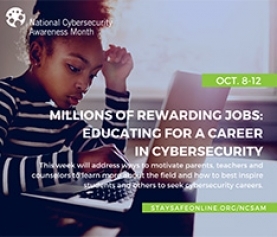October is National Cyber Security Awareness Month (NCSAM). As an NCSAM Champion, SecurityCoverage has pledged to help get out the word about Cyber Security .
The National Cyber Security Alliance (NCSA) and Better Business Bureau (BBB) are encouraging consumers to get their online lives in good order by conducting a thorough cleanse of their cyber clutter. With preventing identity theft a top safety concern for Americans, NCSA and BBB urge everyone to make “annual digital cleaning” a ritual to help protect valuable personal data.
REFRESHING YOUR ONLINE LIFE IS A RELATIVELY SIMPLE PROCESS. NCSA HAS IDENTIFIED THE TOP TROUBLE-FREE TIPS EVERYONE SHOULD FOLLOW.
- KEEP A CLEAN MACHINE: Ensure all software on internet-connected devices – including PCs, smartphones and tablets – is up to date to reduce risk of infection from malware.
- LOCK DOWN YOUR LOGIN: Your usernames and passwords are not enough to protect key accounts like email, banking and social media. Begin your spring cleaning by fortifying your online accounts and enabling the strongest authentication tools available, such as biometrics, security keys or a unique one-time code through an app on your mobile device.
- DECLUTTER YOUR MOBILE LIFE: Most of us have apps we no longer use and some that need updating. Delete unused apps and keep others current, including the operating system on your mobile device.
- DO A DIGITAL FILE PURGE: Perform a good, thorough review of your online files. Tend to digital records, PCs, phones and any device with storage just as you do for paper files. Get started by doing the following:
- Clean up your email: Save only those emails you really need and unsubscribe to email you no longer need/want to receive.
- Back it up: Copy important data to a secure cloud site or another computer/drive where it can be safely stored. Password protect backup drives. Always back up your files before getting rid of a device, too.
- OWN YOUR ONLINE PRESENCE: Review the privacy and security settings on websites you use to ensure they’re at your comfort level for sharing. It’s OK to limit how and with whom you share information.
- KNOW WHAT DEVICES TO DIGITALLY “SHRED”: Computers and mobile phones aren’t the only devices that capture and store sensitive, personal data. External hard drives and USBs, tape drives, embedded flash memory, wearables, networking equipment and office tools like copiers, printers and fax machines all contain valuable personal information.
- CLEAR OUT STOCKPILES: If you have a stash of old hard drives or other devices – even if they’re in a locked storage area – information still exists and could be stolen. Don’t wait: wipe and/or destroy unneeded hard drives as soon as possible.
- EMPTY YOUR TRASH OR RECYCLE BIN ON ALL DEVICES AND BE CERTAIN TO WIPE AND OVERWRITE: Simply deleting and emptying the trash isn’t enough to completely get rid of a file. Permanently delete old files using a program that deletes the data, “wipes” it from your device and overwrites it by putting random data in place of your information ‒ that then cannot be retrieved.For devices like tape drives, remove any identifying information that may be written on labels before disposal, and use embedded flash memory or networking or office equipment to perform a full factory reset and verify that no potentially sensitive information still exists on the device.
- DECIDE WHAT TO DO WITH THE DEVICE: Once the device is clean, you can sell it, trade it in, give it away, recycle it or have it destroyed.
In a time when customer data is getting hacked or stolen at alarming rates, it’s important that consumers do all they can to protect themselves. Getting into a habit of following these steps, where possible, can go a long way to making sure your data stays safe.



